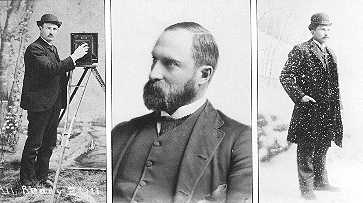 “The Howes brothers, Alvah, Walter, and George — were natives of Ashfield…Western Massachusetts. …During their active years as professional photographers (1886-1906), the three brothers worked largely as itinerants, traveling from place to place and taking pictures of households, school classes, factory crews, shopkeepers, delivery men, and virtually anyone or anything else they could get to stand still long enough… Upon Their arrival in a town that they planned to work, the trio would first arrange for bed and board at a local rooming house. They would then set about soliciting customers, visiting schools and factories to line up orders for group sessions and driving along town streets and country roads, knocking on doors to invite people to have their pictures taken. Prints were sold at three for a dollar…
“The Howes brothers, Alvah, Walter, and George — were natives of Ashfield…Western Massachusetts. …During their active years as professional photographers (1886-1906), the three brothers worked largely as itinerants, traveling from place to place and taking pictures of households, school classes, factory crews, shopkeepers, delivery men, and virtually anyone or anything else they could get to stand still long enough… Upon Their arrival in a town that they planned to work, the trio would first arrange for bed and board at a local rooming house. They would then set about soliciting customers, visiting schools and factories to line up orders for group sessions and driving along town streets and country roads, knocking on doors to invite people to have their pictures taken. Prints were sold at three for a dollar…
During the twenty years that Alvah Howes was active as a photographer, the population of most hill towns either remained stable or declined slightly. This pattern, which dated back to the 1860s or before, contrasted dramatically with the swift expansion taking place in the Connecticut River Valley. …The Howes brothers’ photographs offer mute testimony to these diverging patterns. Little new construction is evident in the pictures of hill-town scenes, and some of [the] most poignant subjects are elderly country people, their bent frames echoing the sagging rooflines of their homes. Both house and householder had seen better days. In the valley, on the other hand, the population boom led to widespread new construction and the Howes photographs of valley locales include numerous pictures of houses and streets with a newly landscaped, just-completed look about them…
[Though the Howes photographs documented] social and economic conditions in western New England during the late nineteen century, [i]t is important to recognize, however, that the Howes pictures were not taken for the purpose of creating a social history archive. The Howes brothers were entrepreneurs in business to sell pictures…
[They] displayed considerable versatility pursuing their trade with apparent ease in both farm and urban areas and in working-class districts and middle-class neighborhoods. Negroes composed only about 1 percent of the state’s population, yet many black people turn up in a wide variety of roles, from very poor farmers and workers to well-dressed professional and business people, including a woman school-teacher, a policeman, and two portraits of black women standing in front of their small business establishments…
The Howes brothers habitually urged clients to bring objects they particularly valued to the photographic session. Workers often carried the tools of their trade, and families lined up with their prize possessions–everything from oxen, chickens, and pets…to lawn mowers, farm equipment and the household’s best chair…
In recent years, the work of the Howes brothers has attracted increasing attention, and rightly so. As an archive of photographs by a single family firm, the Howes collection is unusually large, perhaps the largest of its type in the United States. …By any standard, therefore–quantity and quality, importance historically and photographically–the Howes collection is a major one, a rich legacy of three diligent craftsmen: Alvah, Walter, and George Howes.”
References:
Matthews, Richard, “Through the Eyes of the Howes Brothers,” Hampshire Life, Daily Hampshire Gazette, July 24, 1992.
Return to the Edwards Public Library website.